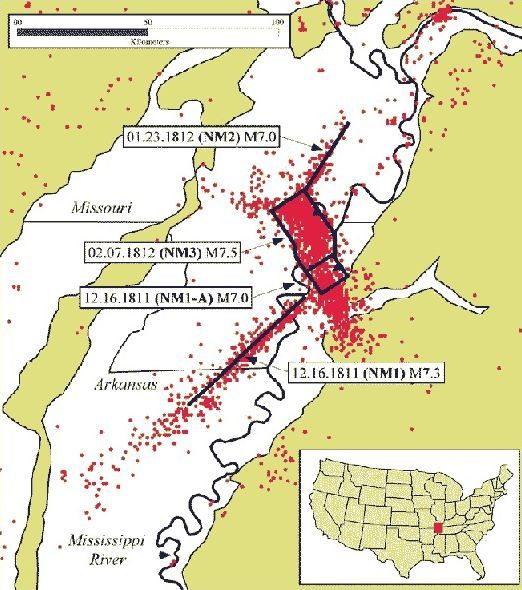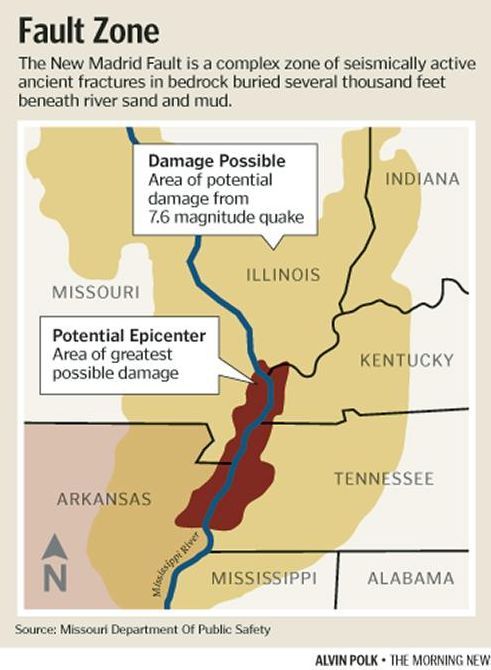Intraplate Quakes
Àuthor: Thomas O'Shea
Source: Experimentation
Modern teachings leave one with the impression that devastating earthquakes are largely manifest of active, subductive tectonic plate boundaries. Indeed this is the case 95% of the time. With this understanding has come a sense of security in that these areas are relatively easy to map and hence so are the human conurbations likely to be affected by the resulting earthquake activity. Thus precautionary measures can be in-built over time to significantly reduce risk to the populations within these areas.
However it would just not be fitting with my trend of scare-mongering and professing apocalyptic scenarios if we just left it at that! So the other 5% of the time can be accounted for by a very infrequent, highly alarming and, judging by historical examples; an equally devastating form of seismic behaviour known as the Intraplate earthquake.
As opposed to interplate earthquakes which occur in and around the boundary between two tectonic plates, an intraplate earthquake can occur anywhere from the immediate vicinity of a tectonic boundary, (but not in it) to deep within any given continental area (figure 1).

Figure 1 – The USGS’ mapped representation of inter and intra – plate earthquakes, the coloured dots on the middle of the continent are intraplate events
Indeed it can be said that this style of seismic phenomena is believed to have a return period of many thousands of years, which in a sense is positive. However, in light of the fact that seismic records have only existed since the 19th century, very few large events have been recorded since the development of large urban areas within continents. Hence intraplate infrequency can be heavily attributed to this, rather than infrequency in geological time.
As a result, intraplate earthquakes can conceivably occur in areas which have not been historically seismically active. Meaning that right where you are sitting at this moment could be at risk and not even your dubiously qualified local seismological shaman would know any different!
It is important to point out that understanding of intraplate phenomena is characterised (alarmingly) by contradictions. As an example I point to one blatantly made in figure 1. For the observant amongst us it might have been realised that intraplate events were stated as being ‘infrequent’, yet figure 1 from the USGS would suggest that there have been quite a number of these events having occurred on the continent.
It is this realisaton that epitomises a general lack of emphasis by modern plate tectonics as a whole and can be explained by the fact that the global average energy release from these events is almost negligible when compared to that associated with earthquakes at plate boundaries. A comprehensive study in 1990, discovered that the globally averaged seismic moment release for intraplate earthquakes is about 1026dyne-cm per year [2]; equating to roughly 0.5% of the global average.
This should not be cause for relief though, as history speaks of intraplate earthquakes which are no less devastating than traditional earthquakes. In 1811-1812 over consecutive months, 4 intraplate events of greater than 7.0Mw (figure 2) raised New Madrid, Missouri to the ground and caused damage to buildings over a thousand kilometres away on the east coast of America[1].

Figure 2 – Illustrating the extent of microseismicity between two ancient fault planes encompassing the New Madrid area. It is the reactivation of these planes which have been used as the primary explanation for the New Madrid example – but exactly what has lead to their reactivation is still as source of heated on-going debate
A similar example, of 7.6 Mw famously destroyed Charlston, South Carolina in 1886. The devastation in both these examples was widespread, and can be associated with a peculiar trait of the rigid continental crust. Being a rigid solid it directly transmits seismic energy far more efficiently than at heavily fractured tectonic boundaries – meaning that a high Mw value is NOT necessitated for intraplate earthquakes to cause severe destruction, as is often associated with their interplate counterparts.
Much like all other aspects of science, understanding has leapt forward in regard to these phenomena. The quakes can be associated with evidence from crustal deformation rates and paleoseismic data, which further supports the consensus that there is a lack of adequate seismic records to account for the intraplate recurrence rates. In light of this it can be said that there is an imperative need to identify areas which may be at risk, but to do this effectively causal mechanics must first be understood. This is the factor which no one can agree on and at this point in time still haven’t done so (because they simply don’t know exactly what they are!).
As of the time of writing, there are three suggested and substantiated (to a degree) mechanical models of intraplate genesis; Stress Concentration, Zone of Weakness and High Heat Flow. Each process possesses its very own associated unique dialect of ludicrously congested scientific jargon, so for the sake of simplicity (and not scarring you with the intimacies of seismology) figure 3 should adequately summarise and explain exactly why we should all be quite worried about intraplate activity.
What figure 3 effectively tells us, is that the 3 mechanisms that may (or may not) act in conjunction with one another within continental locations could lead to possible seismic activity within continental crust i.e. an intraplate earthquake. However the long and short of it is that due to the rarity of such events within modern recorded history, it is simply impossible to know if one or the other of these mechanics acts to cause such events at all ! Indeed the much more lengthy CONS column in figure 3 is extremely telling of the intraplate enigma as a whole! However nil desperandum! As further contemporary study of the significant New Madrid event, within what is now termed the ‘New Madrid Fault Zone’ has revealed significant characteristics which could contribute to understanding both the genesis of intraplate earthquakes as well as their capability of damage propagation some distance from their epicentre (figures 2, 4 & 5).

Figure 4 – The presence of extensive Mississippi flood deposits of loosely consolidated soils suggests that seismic energy could be transmitted very efficiently over large distances from the epicentre. This factor has been suggested as acting a medium of possible widespread and extreme damage in as many as 5 different states as a result of a moderately large, future intraplate event

Figure 5 – Developing figure 3 further, it has been established as recently as 2010 that the New Madrid Fault Zone may infact be a component of a much larger and deeper ancient failed rift zone; where rifting may be subject to dormancy and spontaneous reactivation in a similar process to that seen at conventional tectonic boundaries, the ‘unzipping’ of which is what results in intraplate seismicity, but as stated in figure 3; this continues to be heavily debated
1. Intraplate Earthquakes: Possible Mechanisms for the New Madrid and Charleston Earthquakes http://sprg.ssl.berkeley.edu/matt/seismo.html
2. Johnson A.C. and Kanter L.R. (1990). Earthquakes in stable continental crust. Sci. Am. , 3 (262), 68–75.
3. ‘2002 Dudley earthquake’ available from http://en.wikipedia.org/wiki/2002_Dudley_earthquake
4. ‘1990 Bishop's Castle earthquake’ available from http://en.wikipedia.org/wiki/1990_Bishop%27s_Castle_earthquake
5. ‘2011 Christchurch earthquake’ available from http://en.wikipedia.org/wiki/2011_Christchurch_earthquake
6. England P. and Jackson J. (2011). Uncharted seismic risk. Nature Geosciece , Advance Online Publicatin, 1–2.
7. McCloskey, J. (2011). Focus on known active faults. Nature Geoscience , 4, 1.
8. Campbell D L. (1978). Investigation of the stress-concentration mechanism for intraplate earthquakes. Geophysical Research Letters , 5, 477–479.
9. Liu L and Zoback M D. (1997). Lithospheric strength and intraplate seismicity in the New Madrid seismic zone. Tectonics , 16, 585–595.
10. Sykes L R. (1978). Intraplate siesmicity, reactivation of preexisting zones of weakness, alkaline magmatism, and other tectonism postdating continental fragmentation. Rev. Geophys. , 16, 621–688.